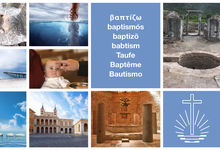The sacraments (51): Two handfuls of spiritual gifts
Sealing is a sacrament with a history. And its roots can be traced back to the early Christian centuries. Here is an overview of the ten articles in our series on this topic and a look ahead on what is up next.

It is a must. Jesus Himself made this clear: “Most assuredly, I say to you, unless one is born of water and the Spirit, he cannot enter the kingdom of God” (John 3: 5). Of course, the bath of regeneration mentioned in Titus 3: 5 is a reference to water baptism.
So how does a Christian get access to the Holy Spirit? This is a question that Christians of all times and in all denominations ask. Through the sacrament of Holy Sealing. That at least is the answer in the New Apostolic Church.
This is one of many different answers on the Christian spectrum. There are those who understand baptism of the Spirit as a spontaneous event that is beyond the control of human beings. Other see it as the work of one or another human hand.
This diversity is already present in the Bible. In fact, the New Testament gives several answers to the question of “the renewing of the Holy Spirit”. And they do not always agree.
So the early church developed its baptismal rite in several parts. In addition to the water bath from the gospels, it also includes the laying on of hands from Acts and the anointing with oil. The latter refers to Jesus Christ as the Messiah, in other words, the Anointed One.
In the west of the Roman Empire, the laying on of hands and anointment were closely tied to the bishop ministry. However, from the fourth century onwards, bishops no longer needed to be present when priests baptised. This is how the Catholic rite of confirmation became an independent sacrament.
The reformers in the early sixteenth century had their problems with this. Nevertheless, they went on to develop their own confirmation: in which Christians who have reached the age of reason confirm their childhood baptism.
At first, the Catholic Apostolic Church experienced the baptism of the Spirit as individual flashes of inspiration. At first there was euphoria, followed by disillusionment. When a hoped-for collective experience like the Pentecost event failed to take place, the Apostles took matters into their own hands.
In 1847 the Catholic Apostolic Church introduced the “laying on of apostles’ hands”, also known as “sealing”. The theological foundation only developed over time—to the point of it being necessary for salvation.
In the emerging New Apostolic Church the provisional Catholic Apostolic sacrament developed into an identity-generating principal sacrament. Here it was no longer just a strengthening, but the primary act of imparting the Spirit.
The New Apostolic sacraments have their foundation in the life and activity of Jesus Christ. This also applies to sealing. The Catechism sets out in detail the carefully constructed and current understanding.
After exploring the basics of sacramental theology and the three New Apostolic sacraments, the nac.today series will turn to a fifth subject for the coming weeks, namely sacraments for the dead.

















